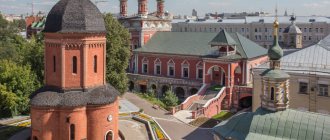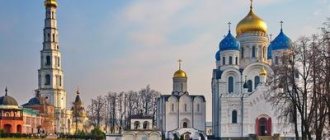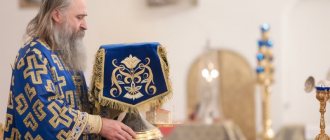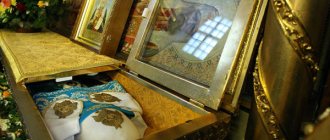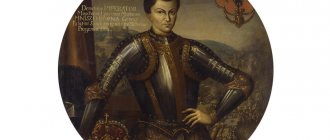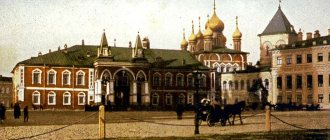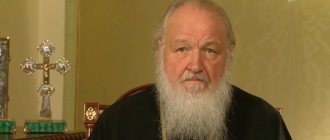On January 12 (December 30, Art. Art.), the memory of St. Macarius, Metropolitan of Moscow, is celebrated. Under him, two Councils were convened: 1547 and 1549, at which the issue of glorifying the ascetics of piety was raised. These Councils were of great importance for the life of the church and went down in history under the name “Makarievsky”. In 1551, under the leadership of the saint, the Council of the Hundred Heads was held, which confirmed, among other things, the sanctity of the double finger. Metropolitan Macarius also compiled the Great Chetya Menaion, which included the lives of saints, works of church writers, collections of patericons, texts of a historical and moralizing nature by Russian authors, arranged in order of celebrating the memory of saints according to the Orthodox calendar for each month.
Life of Saint Macarius, Metropolitan of Moscow
The future Metropolitan Macarius was born around 1482 in Moscow into a family of virtuous parents. At baptism he was named Michael, in the name of the Archangel Michael. Mikhail's father, Leonty. died shortly after the birth of his son. His mother subsequently took monastic vows with the name Euphrosyne.
Mikhail decided to choose the path of a monk for himself and entered the Nativity of the Mother of God Pafnutievo-Borovsky Monastery as a novice. During his tonsure he was named in honor of St. Macarius the Great. In 1523, Macarius became abbot of the Luzhetsky Mother of God Monastery in Mozhaisk. Being the abbot of the monastery, he started a monastic synod, establishing the commemoration of all the brethren who had previously died, and built a chapel in the monastery cathedral in honor of the Monk Macarius the Great. In 1526, Macarius was installed as Archbishop of Novgorod. The ordination took place in the Assumption Cathedral of the Moscow Kremlin. Archbishop Macarius took care of the missionary education of the northern peoples of the vast Novgorod land. In 1528, fulfilling the decree of the Moscow Council of 1503, Archbishop Macarius decided to introduce cenobitic regulations in all Novgorod monasteries. He showed great concern for the creation and decoration of churches in his diocese and, above all, in Veliky Novgorod. In total, under Saint Macarius, in Novgorod alone, about forty churches were built, rebuilt and re-decorated after fires, for which books were written, church utensils and vessels were made in the lord's workshop. Archbishop Macarius devoted a lot of energy and care to serving his neighbors. During pestilence and drought in Veliky Novgorod, the archbishop performed prayer services with a special rite of washing the holy relics and then sprinkled everything in the surrounding area with this water. Soon the pestilence and epidemic ceased. Archbishop Macarius repeatedly made long trips throughout the diocese. He also visited outside of it. Thus, during his tenure at the Novgorod see, he visited Moscow twice: in 1535 at the call of the sovereign power and in 1539, when he headed the election and installation of the new Metropolitan Joasaph. It is known that Saint Macarius made great efforts to eradicate various false teachings. At the Council of 1553, the heresy of Matthew Bashkin and Theodosius Kosoy was condemned. With the blessing of Saint Macarius, a new chronicle was compiled in Veliky Novgorod, and the lives and services of Russian saints were written. The nephew of the Venerable Joseph of Volotsky, the monk Dosifei (Toporkov), worked on correcting the text of the Sinai Patericon, which was then included by the saint in the Great Chetya Menaion; Later, the monk Dosifei wrote the Volokolamsk Patericon and compiled the Chronograph.
On March 19, 1542, Archbishop Macarius was elevated to the metropolitan throne. At the Councils of 1547 and 1549 The issue of church-wide glorification of Russian saints was being resolved. Before this, the glorification of saints was carried out in Rus' by the decision of the local bishop, so ascetics were revered only in the lands of their labors and exploits. The Makariev Councils revealed an entire era in the history of the Russian Church, “the era of new wonderworkers,” as all the newly canonized Russian saints were then called. The chronology of their names covers almost the entire period of Christianity in Rus' by that time. These Councils caused a great spiritual upsurge in Russian society. The glorification of the ascetics required the writing of new services for them with liturgical instructions of a typical nature on the order of their performance, as well as the creation again or editing of their previously written lives. Historian E.E. Golubinsky writes that during the 20-year reign of Metropolitan Macarius, “almost one-third more lives of saints were written than in the entire preceding period from the Mongol invasion, and if we count the new editions of previous lives, then almost twice as many.”
It is known that Metropolitan Macarius became blind in one eye; this probably could have happened to him during the great fire in Moscow in 1547. Leaving the Assumption Cathedral, in which he almost suffocated from the smoke, the metropolitan managed to take out of it the image of the Virgin Mary, painted by the wonderworker Peter. Behind him was the cathedral archpriest with a book of church rules. The people who accompanied the Metropolitan died from burns and suffocation. Metropolitan Macarius miraculously escaped, but during the fire, as a contemporary wrote, “his eyes were scorched by the fire,” so that, obviously, his right eye ceased to see at all.
At the beginning of 1551, the Hundred-Glavy Council, convened by Metropolitan Macarius, began work in the royal chambers of Moscow. It examined a variety of issues relating to the appearance of a Christian and his behavior and piety, church deanery and discipline, icon painting and spiritual enlightenment. After the Council, mandate letters were sent to various parts of the Russian metropolis, which were then used as the basis for conciliar decrees in their preparation and editing. The cathedral received in history the name Stoglavy, since its materials are presented in one hundred chapters.
In 1552, Metropolitan Macarius blessed Tsar John IV to go to Kazan and predicted his future victory and victory[1]. Later, in memory of this event, the Cathedral of the Intercession on the Moat was built in Moscow. On February 3, 1555, Metropolitan Macarius appointed Bishop Guria to the new Kazan see.
Metropolitan Macarius blesses Ivan the Terrible during his royal crowning. Miniature from the Royal Book. 1560s(?)
It is known that the Metropolitan foresaw the coming disasters of the Russian land, which the oprichnina brought to it, established by the Tsar shortly after his blessed death: “At no time during the night did the saint stand in the usual prayer and say in a great voice: “Oh, I, a sinner, am more than all men! How can I see this! Wickedness and division of the earth is coming! Lord, have mercy, have mercy! Quench your anger! If you had not had mercy on us for our sins, otherwise it would not be with me, for me! Lord, don’t let me see this!” And shed great tears. And then I heard it from the cell attendant, a certain spiritual person, and was surprised at this, and thought to myself: “Who is he talking to?” And not seeing anyone, you were surprised at this. And he spoke to him spiritually about this: “Wickedness is coming, and hemorrhage, and division of the earth.” One day Tsar John IV asked Metropolitan Macarius to send him a helpful book. Having received the Order of burial, he was angry with the Metropolitan: “You sent me to be buried, but such books cannot be brought into our royal palaces.” And Macarius said to him: “I, your pilgrim, sent simply by your order, that you ordered me to send a book useful for the soul; and she is the most useful of all: if anyone respects her attentively, he will never sin.”
In September 1563, Metropolitan Macarius performed a religious procession, during which he caught a severe cold and fell ill. Just before his death, the Metropolitan expressed a desire to the Tsar to retire to the monastery, even wrote to him about this in a letter, but by the will of the Tsar he was forced to refuse this again. Metropolitan Macarius reposed on January 12 (December 30, Old Style), 1563. “At his burial there was the Tsar and Grand Duke of All Rus' Ivan Vasilyevich and Prince Vladimir Andreevich, and princes, and boyars, and nobles, and a multitude of people. Nikander, Archbishop of Rostov and Yaroslavl, was then at the funeral; Athanasius, Bishop of Suzdal and Tarusa; Philotheus, Bishop of Ryazan and Murom; Varlaam, Bishop of Kolomna and Kashira; Matthew, Bishop of Sarsk and Podonsk; archimandrites and abbots with the consecrated cathedral”[2].
early life
In the world, Mikhail Petrovich Bulgakov, was born into the family of an Orthodox pastor, in the village of Surkovo, Kursk province, on September 19, 1816.
Mikhail's father, priest Peter, served in a rural church and was known among the parishioners as a good and obliging shepherd. For many peasant children, he was not only a priest, but also a godfather.
Mikhail's mother, Stefanida Grigorievna, a gentle but sensible woman, was the daughter of a clergyman, Grigory Spassky. She knew how to measure her life against God's law, prayed a lot, and fasted more strictly than the Church Charter prescribed.
The Bulgakov children were raised in the spirit of faith and Christian love from an early age. Mikhail was the third child in the family (there were six in total). He was born weak and suffered a lot as a child (mostly scrofula).
The head of the family, priest Peter, died early (Mikhail was 7 years old at that time, the eldest daughter Stefanida Grigorievna was 10, and the youngest was 3 years old). The burden of caring for the children fell entirely on the shoulders of the widow. They lived hard, they rather survived, they didn’t have enough money, but they didn’t fall into despair, they trusted in God.
In 1823, Mikhail’s mother sent him to the priest and godfather, Pavel Nikitsky. He served several miles from their village and ran a home school. Here Mikhail learned to read and write and received moral training.
Two years later, his mother took him to Korocha and enrolled him in the parish religious school. Education was difficult for Mikhail: poor health affected both the difficulty of concentrating on educational material and dulling of memory. However, thanks to diligence and perseverance, he still achieved the desired success.
In 1827, Mikhail continued his education at the District School, located in Belgorod, under the same roof as the Kursk Seminary.
While undergoing training, Mikhail avoided games, preferring communication with literature to youthful entertainment. One day, when he was engaged in soulful reading in the yard, a stone flew at him. The cobblestone was thrown by one of his peers and was not intended for him personally, but by chance it hit him right in the head.
A wound has formed. Surprisingly, with its healing, Mikhail was freed from the scrofula that tormented him. But what’s even more surprising is that this event affected his mental abilities: in the absence of illness, thanks to the hard work he had previously developed, Mikhail rose from the laggards to the ranks of the best students.
Soon, amazed by his answers in the exam, the Kursk Archbishop, Iliodor, drew attention to him. Having found out the circumstances of his family’s life, he awarded Mikhail’s mother a pension of 100 rubles, and helped his three sisters marry future priests.
Veneration of Saint Macarius, Metropolitan of Moscow
The veneration of Saint Macarius, Metropolitan of Moscow, began immediately after his death. Soon his first icon appeared on the tomb. It is known that, having returned from the Lithuanian campaign of 1564, the tsar kissed the images of Saints Peter, Jonah and Macarius in the Assumption Cathedral, “kindly kissing them.” The name of the saint, starting from the 17th century, is found in the “Tale of the Holy Icon Painters,” which says: “Holy, wonderful, and wonderful Macarius, Metropolitan of Moscow and All Russia, wonderworker, wrote many holy icons, and books, and the lives of the holy fathers throughout the year , Menaion Chetya, like no one else, wrote from the Russian saints and commanded the Russian saints to celebrate, and at the Council set out the rule, and wrote the image of the Most Holy Theotokos of the Dormition.” In 2002, Metropolitan Macarius of Moscow was canonized by the Russian Orthodox Old Believer Church as a saint.
On the path to monasticism and priesthood
At the Kursk Seminary, where Mikhail was enrolled after college, he stood out from the general row of students so much that some teachers, either jokingly or seriously, called him, a very young man, by his first name and patronymic.
In 1833, during an exam, Mikhail met the rector of the seminary, Archimandrite Elpidifor, and he began to take special care of the student: he took him on vacation and allowed him to live in his apartment. Mikhail learned a lot of good things from him.
In 1837, after successfully completing a seminary educational course, he entered the Kyiv Theological Academy for further education.
During this period, the desire to unite his life with monastic work matured and took shape in Mikhail’s soul. This desire was realized in the last year of his studies: in 1841, as a twenty-five-year-old young man, he finally renounced the world and took monastic vows. His new name was Macarius. So it was named in honor of the holy martyr, Metropolitan of Kyiv Macarius.
In the same year, Macarius was ordained a hierodeacon, and soon, upon completion of his academic course, he was awarded the rank of priest.
Works of Saint Macarius, Metropolitan of Moscow
Saint Macarius made a huge contribution to the development of ancient Russian writing. While still in Novgorod, he continued the works of Archbishop Gennady. And if Archbishop Gennady collected biblical books, then Bishop Macarius set the goal of collecting all the spiritual literature in Rus'. He began his work on systematizing Russian church literature in 1529. This undertaking received in history the name of the Great Fourth Menaion. Their first edition was contributed to the Novgorod St. Sophia Cathedral in 1541, the second in the 1550s was given as a contribution to the Kremlin Assumption Cathedral, and the third was later received by the first Russian Tsar. The Menaions contain and edit various lists of the lives of many saints, the theological and patriotic heritage of the Russian Church.
In 1552, the second edition of the Great Menaions of the Four was included in the Moscow Assumption Cathedral. In this book, the title of which is translated as Great Monthly Readings, Macarius tried to collect the entire corpus of books for reading, blessed by the Orthodox Church, that existed in Ancient Rus'. On his initiative, the first systematic work on Russian history was created - The Powerful Book of the Tsar's Genealogy. With the blessing of Metropolitan Macarius of Moscow, Russian book printing begins by Deacon Ioann Fedorov.
Under Metropolitan Macarius, two Councils were convened: 1547 and 1549, at which the issue of glorifying the ascetics of piety was raised. These Councils were of great importance for the life of the church and went down in history under the name “Makarievsky”. The following were canonized: Alexander Nevsky; Vsevolod Pskovsky; Nikon of Radonezh; Savva Storozhevsky; Metropolitan Jonah; Pafnuty Borovsky and others.
Episcopal ministry.
In 1850, Father Macarius was consecrated Bishop of Vinnitsa and appointed to the post of rector of the St. Petersburg Academy.
During his management of the academy, it was distinguished by good organization of the educational process and student life. It is noteworthy that while acting as rector, Bishop Macarius did not abandon the teaching path.
In 1853, he formed a missionary department at the academy. One of his main tasks was to counter schismatics.
Another career of Bishop Macarius was the editing of the publication “Christian Reading”. In addition, during these years he wrote and published his articles of various theological orientations.
Saint Macarius, Metropolitan of Moscow. Icons
The earliest image of St. Macarius, Metropolitan of Moscow, is on a four-part icon of 1547 in the Annunciation Cathedral of the Moscow Kremlin. In its lower left part, among other famous persons, the Tsar and Metropolitan Macarius are written.
"Four-part" icon. Mid-16th century Moscow Annunciation Cathedral of the Moscow Kremlin
Another image from 1560 was created in the altar of the Assumption Cathedral of the Sviyazhsk Monastery on the fresco “Let all human flesh be silent...”. On icons, Saint Macarius is depicted as a dry, tall, gray-haired old man. “Metropolitan Macarius, old and gray-haired, in a golden sakkos and a green omophorion, on which there are black and gold crosses; on the head is a saint's cap, the top with multi-colored stones.
Bogolyubskaya icon of the Most Holy Theotokos with selected saints (tripartite folding panel). The frame depicts the Moscow saints Peter, Photius, Macarius, blessed Maxim, John. Istoma Savin. End of the 16th - beginning of the 17th century. Moscow, State Tretyakov Gallery
Cathedral of Moscow Saints (fragment). 2nd half XVII century. Drawing (Translation from the icon by V.P. Guryanov)
St. Macarius of Moscow with his life. Icon. Sergiev Posad. 1990s
[1] Facial chronicle vault. Russian history in 24 books. Russian chronicle history. Book 21 (1551–1553). L. 184-198. [2] Facial chronicle vault. Russian history in 24 books. Russian chronicle history. Book 23 (1557–1567). L. 293, 294.
Tambov department
In 1857, Macarius Bulgakov received a new appointment - to head the Tambov diocese. By the time of his ascension to the Tambov See, the diocese was in a depressing state.
Arriving at the place, he quickly got his bearings, got acquainted with the state of affairs, began to eliminate shortcomings: he removed irresponsible employees, personally participated in resolving diocesan issues, assembled the parish clergy, had conversations with them, visited parishes, preached, personally inspected the condition of churches, organized construction new churches, appointed worthy clergy to them.
They note that in his relations with people the bishop was sensitive and affectionate, but he punished those guilty of serious offenses.
Advocating for the education of the clergy, Bishop Macarius began to subscribe to theological literature for parish libraries. The priesthood actively accepted this initiative and asked for blessings to purchase the works of Bishop Macarius himself, which was fulfilled.
He paid a lot of attention to the fight against schismatic sentiments. For this purpose, I repeatedly met with people, explained what obedience to the Church consists of and what internal unity should be built on. In addition, he encouraged missionary pastors.
The actions of Makarii Bulgakov in relation to the establishment of strict church discipline were not accepted sympathetically by everyone. They began to intrigue against him, spread false rumors, and inform where they should. As a result of this confrontation, in 1858, St. Petersburg was filled with rumors that the Bishop of Tambov was shamelessly forcing priests to buy his literary works.
The situation in the diocese has worsened. The undeserved accusations shocked Bishop Macarius so much that he began to desire a speedy move from his see to another, especially since the local climate had a bad effect on his physical health.
Kharkov diocese
In 1859, Bishop Macarius was appointed to the Kharkov See. Unlike the Tambov diocese (as it was before his accession), the Kharkov diocese was distinguished by exemplary order and amenities. Temples were maintained at the proper level, the clergy was disciplined and educated, several theological schools and a seminary operated in Kharkov.
Having assumed his duties, Bishop Macarius inspected the condition of educational institutions. He highly appreciated the activities of the seminary. In order to improve the working conditions of teachers, he increased their salaries at the expense of the diocesan treasury. In addition, he allocated additional funds for the maintenance of students. The school buildings were renovated.
Increasing the efficiency of his work, he established the election of deans on his territory, established congresses, increased the number of deaneries, transferred the authority to congresses to resolve a number of diocesan issues, and filled deanery libraries with literature.
In 1862, Macarius Bulgakov was elevated to archbishopric dignity.
In the same year, he organized the activities of the monthly publication “Spiritual Messenger”. Another magazine published through his efforts was the Spiritual Diary.
Literature
- Shishov A. All-Russian Metropolitan Macarius and his merit for the Russian Church // Wanderer. 1869, no. 12.
- Macarius, Archbishop Lithuanian and Vilensky. Moscow Metropolitan Macarius as a literary figure // Christian reading. 1873, no. 4.
- Lebedev N. Macarius, Metropolitan of Moscow (1482-1563). M.
- Zaussinsky K. Macarius, Metropolitan of All Russia // ZhMNP (for a list of abbreviations, see the end of the article. - Ed.), 1881, No. 10.
- Golubinsky E.E. History of the Russian Church. T. 2. Part 1. M.
- Volnyansky N. Metropolitan Macarius - the torch of Russian culture // ZhMP, 1947, No. 6.
- Muravyov N. Metropolitan Macarius as the compiler of the Great Four Menaia (To the 400th anniversary of the compilation of the Great Four Menaia) // ZhMP, 1953, No. 5.
- Macarius (Veretennikov), abbot. Metropolitan Macarius of Moscow and the church and literary activities of his time. // Millennium of the Baptism of Rus'. International church scientific conference “Theology and Spirituality”. Moscow May 11-18, 1987 - M.: Publication of the Moscow Patriarchate, 1989. - T. 2.
- Macarius (Veretennikov), abbot. All-Russian Metropolitan Afanasy (1564-1566). — BT, Sat. 25. - M., 1984.
- Makariy (Veretennikov), archimandrite. “ Moscow Metropolitan Macarius and his time
” M., 1996. - Makariy (Veretennikov), archimandrite. “ The life and works of St. Macarius, Metropolitan of Moscow and All Russia.
"M., 2002. - Makariy (Veretennikov), archimandrite. “ St. Macarius, Metropolitan of Moscow and the bishops of his time
” M., 2007. - Makariy (Veretennikov), archimandrite. " Holy Russia: Hagiography. History. Hierarchy
" M., 2005.
